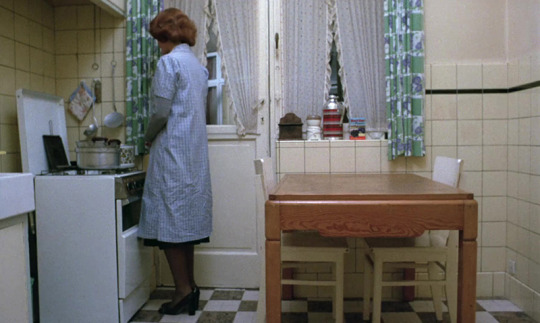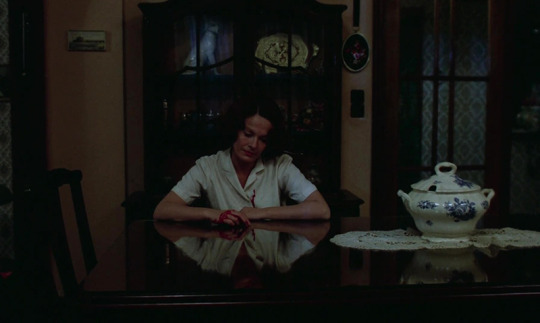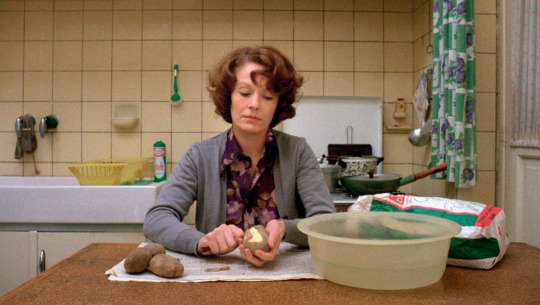#Yves Bical
Explore tagged Tumblr posts
Photo


JEANNE DIELMAN, 23, QUAI DU COMMERCE, 1080 BRUXELLES (Chantal Akerman, 1975)
Sight and Sound: The Greatest Films of All Time
#jeanne dielman 23 quai du commerce 1080 bruxelles#jeanne dielman 23 commerce quay 1080 brussels#chantal akerman#delphine seyrig#jan decorte#henri storck#jacques doniol-valcroze#yves bical#film#cine
25 notes
·
View notes
Text

Delphine Seyrig in Jeanne Dielman, 23 Commerce Quay, 1080 Brussels (Chantal Akerman, 1975)
Cast: Delphine Seyrig, Jan Decorte, Henri Storck, Jacques Doniol-Valcroze, Yves Bical. Screenplay: Chantal Akerman. Cinematography: Babette Mangolte. Art direction: Philippe Graff. Film editing: Patricia Canino.
With Jeanne Dielman (to shorten its unwieldy title) Chantal Akerman tests the medium to see whether a story can be told without melodrama, without excess camera movement, without a music track, without all the usual cinematic techniques. She also tests the audience, to see if they will sit through a 201-minute film in which minutes go by without anything happening other than a woman taking a bath, washing the bathtub, preparing dinner, eating it with her son, washing dishes, and so on -- all in long takes with no apparent forward narrative drive. The answer is yes, a story can be told that way. As for the audience, I wouldn't recommend it to anyone who doesn't have a high tolerance for cinematic riddles, or who can't sit raptly looking at a painting in a museum for minutes on end. Most of the scenes are filmed straight on, as if looking at them through a frame. In short, Akerman treats a kinetic medium, motion pictures, as if it were a static medium like painting. Is it the greatest film of all time, as has been claimed? I think it's at least a great film, but I don't have any urgent desire to see it again soon. What it did to me was make me aware of watching, of patiently waiting to see what image would be presented to me next, what piece of the puzzle that is Jeanne Dielman (Delphine Seyrig) would fall into place. It takes place over the course of three days, on the first of which Jeanne presents herself as a supremely capable and precise person, going through the motions of her daily existence (which include receiving a man into her bedroom, because she makes a living for herself and her son by discreet prostitution) with calm efficiency. On the first two days, we don't follow her into the bedroom with her client, but the camera lingers in the hall, looking at the bedroom door, until the light fades enough to indicate a passage of time, whereupon she and the man emerge from the bedroom and go to her apartment door, where he pays her and indicates that he will see her again in a week. She then goes to her dining room and puts the money in a blue-and-white tureen, whose lid makes a satisfying clink when she covers it. (In the absence of a music track, ambient sounds take on a greater role.) Later, her son, Sylvain (Jan Decorte), comes home from school and they have dinner, listen to the radio, go out for a walk, and come back home to rearrange the living room furniture so he can unfold the sofa for his bed. They go to sleep. But because many of these incidents are presented in real time, we are allowed to examine them in detail, to notice the furnishings of the apartment and the lack of affect of both mother and son, who have settled into a routine. We also notice the way a blue light, apparently from a sign outside their apartment, bounces off the surfaces of the furniture: It flashes and flickers in a way that suggests a rhythmic repetition but never quite resolves itself into a pattern. In that regard it's unlike Jeanne and Sylvain, who clearly have a pattern to their lives. And that's why it's a shock on the second day -- which begins about an hour into the film -- when Jeanne fails to do up a button on her housedress, something that Sylvain brings to her notice. Or later, when other elements of the pattern of her life don't fall in place: She burns the potatoes she is preparing for dinner; she forgets to switch off a light when she moves from room to room; she fails to put the cover on the tureen after putting the money from the second day's client into it. In any other context than the one established by the first day depicted in the film, these details would be insignificant. But Akerman makes them significant, even troubling, by having made us aware of the cold precision of Jeanne's routine. That this eventually builds to a remarkable climax (I use the word advisedly but not facetiously) is made possible by the mastery with which Akerman has set up her film. I kept wondering what Alfred Hitchcock, the master of voyeurism in cinema, might have made of Jeanne Dielman, a film that makes voyeurs of us all.
2 notes
·
View notes
Text
Jeanne Dielman, 23, Quai du Commerce, 1080 Bruxelles
Recensie Jeanne Dielman, 23, Quai du Commerce, 1080 Bruxelles ★★★★1/2 - te zien op @IFFR Unleashed: 50/50 Een tijdloze parel waarin je een fascinerend traag schouwspel krijgt voorgeschoteld. Wat een climax! #JeanneDielman
De dramafilm Jeanne Dielman, 23, Quai du Commerce, 1080 Bruxelles gaat over Jeanne, die alleen met haar tienerzoon woont. Iedere dag is hetzelfde voor haar, waarbij huishoudelijke taken de boventoon voeren. Wat wij van Jeanne Dielman, 23, Quai du Commerce, 1080 Bruxelles vinden, lees je in onze recensie. Continue reading

View On WordPress
#Chantal Akerman#Delphine Seyrig#dramafilm#Frankrijk#Henri Storck#IFFR Unleashed: 50/50#Jacques Doniol-Valcroze#Jan Decorte#Jeanne Dielman#Jeanne Dielman 23 Quai du Commerce 1080 Bruxelles#review#Yves Bical
1 note
·
View note
Photo







Jeanne Dielman, 23 quai du Commerce, 1080 Bruxelles, 1975 (dir. Chantal Akerman)
74 notes
·
View notes